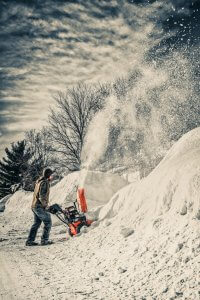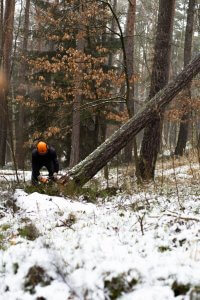- today
- label Guide
- favorite 0 likes

Trust new technologies
Winter workwear is perhaps the most problematic issue in workwear in general. Well, maybe apart from the issue of multi-size clothing.
Why? Because many myths passed down to us by older generations come to the fore here, the lack of experience in the selection of such clothing, a fairly strong backwardness of the workwear market in Poland when it comes to the selection of modern technologies used in the production of clothes.
After all, membranes, insulators, and impregnates have been in the mountain and sports clothing sector for years. Unfortunately, for the time being, when we propose a jacket with a breathable membrane to the builders at the construction site, we can expect laughter and pats on the shoulder at best. Well, no wonder, since for the last 15 years, thick wadded suits dominated at construction sites, in warehouses, in workplaces, in which it is neither comfortable, nor warm, nor practically.
Be like a climber at the construction site!
Yes, it's not a joke, if you work on roofs, on scaffolding, on platforms or poles, your working conditions do not differ from those you can meet in the mountains. So why do you want to choose an outfit for a walk around Krupówki in Zakopane? No, we don't mean that the fur jacket has gone out of fashion a long time ago, but that using it is more or less like driving a Trabant to a construction site, instead of a modern SUV - apparently you still can, but for what sins.
Okay, great, you threw away your old work pouch .... but what next. First, a bit of technique. Unfortunately, work clothes that will keep us warm (except for the few models with a battery heater) have not yet been created. So we have to rely on the heat that our body naturally produces to keep warm in low temperature conditions. When we start to produce too much heat, our body's natural product will also be moisture, and then water vapor. It is these two factors that we have to tame in order to choose well-suited work clothes for the winter - tame heat and steam / moisture.
But before we go any further, before you choose your set of winter workwear, think about what you really need. Insulated pants and an insulated jacket? In our opinion, if you are not grazing penguins on glaciers or building an igloo with Eskimos, it might not be a very good idea :).
When deciding to purchase workwear, take the following factors into account:
1. How often do you work in winter in the rain / snow and you cannot hide under the roof? Thanks to this, you can decide whether the top layer should be a layer of high water resistance or you would rather not get wet quickly when going from the construction site to the covered container.
2. How fluctuating is the intensity of your work during the day? Do you sometimes carry heavy objects, bend down, squat, and then stand in one place for a long time? Or maybe you stand with a lollipop all day and direct the traffic outside? Based on this information, you can take a look at the second layer, which is responsible for insulation. Choose a stronger insulator if you are standing a lot, or something with better permeability if you work with variable amperage.
3. Are you able to safely remove your clothes while working? Or do you hang on a rope all day, repairing masts and telephone antennas?
The answer to these questions will allow you to choose between clothes for static work - that is, one that must guarantee maximum thermal insulation, and clothes for dynamic work, in which high moisture permeability and the possibility of quick temperature regulation during work are more important.
A well-dressed specialist is like an onion .... he has layers :)
As we mentioned before, there is not yet a wise one born who would come up with a garment that warms us by itself (and does not require a battery). Heat, i.e. air warmed up by our body, should be properly closed in the so-called insulating layers that are created between successive layers of work clothes. There are three most common layers of clothing:
- base - consisting of thermoactive clothing made of polyester, polyamide, natural materials such as wool. This layer is designed to carry away the moisture generated by the production of heat by our body and create the first insulation layer for our skin. Choose more artificial materials if you move a lot at work, you perform physical work with high variability in intensity - they will cope better with the transport of moisture. Choose a fabric with an admixture of merino wool if you do not move much at work outside, e.g. you supervise the work of others;) - you will provide yourself with better insulation. It is important that the material from which the base layer is made has very good moisture absorption and drainage properties. Thanks to this, our skin will remain dry, and the layer will not work like the so-called. cold compress. Therefore, we absolutely do not use cotton clothing here.
- the second layer - for which a good insulator must be used. Insulators are usually materials such as synthetic or natural down, Primaloft materials. But, but, but ...... in order not to go to extremes, for Polish conditions that are not very harsh, we only need a decent fleece, preferably a microfleece, which is thin but insulates very well and does not restrict movement. Forget about heavy blanket fleece with a high grammage - the same effect can be achieved, for example, by using ultra-thin fleece made, for example, of Dryplexx material from Engelbert Strauss. Whoever has dressed once knows that thin does not mean that it is not warm. The second layer is very important to us, because it is designed to retain the most heat for us and remove as much moisture as possible to the third layer.
- the third layer - i.e. variously called outer shell / hardshell / shell - all these complicated names simply define the barrier that this layer is to create to protect us from wind and rain. We use two types of solutions here:
a. Vapor-permeable materials - membranes that protect against wind and are waterproof, and at the same time allow the transport of excess moisture that collects on the third layer
b. Softshell materials - which give us limited protection against rain (because they do not are waterproof), but they offer much better vapor permeability than waterproof jackets. This solution is especially recommended where, in the event of rain, you can stop working and take shelter in a roofed place.

What are these layers for? Again some sellers' ideas!
Mr. Marian, if it were so, the whole world of mountaineering, climbing and winter sports would wear woolen sweaters and down suits as in the times of the first conquerors of Mount Everest. The layers are to guarantee you excellent thermal insulation by keeping the already heated air under your clothes - thanks to which your body will use less energy to warm itself up (i.e. less energy, less fatigue, greater efficiency - it seems that only pluses). Additionally, the layers are designed to transport excess moisture from your skin to the outside of your garment, or to layers that are not in direct contact with your skin. Thanks to this, you will avoid the so-called wet compress.
Are you working statically? Is it dynamic?
If you work mostly statically and your job involves e.g. patrolling the area, controlling traffic or similar activities, you must choose clothing that provides excellent thermal insulation. Your body will not be forced to produce a lot of heat, so you just need to choose the right insulator and keep warm under your clothes.
However, if you are a roofer, carpenter, builder and during work you will have to climb the roof, climb the scaffolding, carry bags with construction chemicals, the most important for you will be the breathability parameters, thin layers from which you will be able to undress during intense work.
I will spite my parents and frostbite my ears
Those who insulate buildings know that one thermal bridge can significantly reduce the efficiency of the entire building insulation system. Whoever repairs roofs knows that one leak can perfectly destroy the rest of a well-made roof. This can also be the case with your work clothes!
The human body and circulatory system are built in such a way that blood transported from a well-heated center can travel to poorly heated limbs and cool there, and then return, cold, to our heated center :). Yes, yes, it's not quantum physics, but simple biology. That is why it is important to take care of your hands, head and feet protection in addition to warm clothes. Forget that you will be comfortable working if you don't take care of these elements.
What too much is not healthy
Does the use of insulated trousers, insulated jacket, hats, gloves, etc. always guarantee you good thermal comfort at work? Of course not, only the right selection of all elements of workwear will make you work freely, comfortably and in thermal comfort all day long. After all, work is supposed to give you pleasure.
